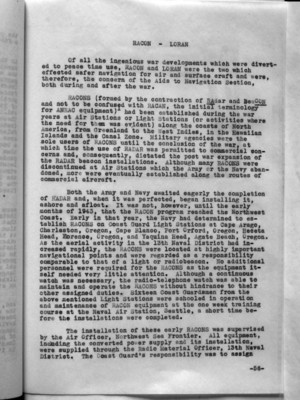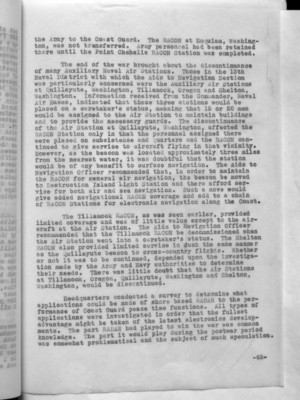Pages That Mention Air Stations
Coast Guard District narrative histories 1945
76
Of all the ingenious war developments which were diverted to peace time use, RACON and LORAN were the two which effected safer navigation for air and surface craft and were, therefore, the concern of the Aids to Navigation Section, both during and after the war.
RACONS (formed by the contraction of RAdar and BeaCON and not to be confused with RACAN, the initial terminology for ANRAC equipment)¹ had been established during the war years at Air Stations or Light Stations (or activities where the need for them was evident) along the coasts of North America, from Greenland to the West Indies, in the Hawaiian Islands and the Canal Zone. Military agencies were the sole users of RACONS until the conclusion of the war, at which time the use of RADAR was permitted to commercial concerns and, consequently, dictated the post war expansion of the RADAR beacon installations. Although many RACONS were discontinued at Air Stations which the Army or the Navy abandoned, more were eventually established along the routes of commercial aircraft.
Both the Army and Navy awaited eagerly the completion of RADAR and, when it was perfected, began installing it, ashore and afloat. It was not, however, until the early months of 1943, that the RACON program reached the Northwest Coast. Early in that year, the Navy had determined to establish RACONS on Coast Guard Light Stations at Cape Arago, Charleston, Oregon, Cape Blanco, Port Orford, Oregon, heceta Head, Florence, Oregon, and Yaquina Head, Agate Beach, Oregon. As the aerial activity in the 13th Naval District had increased rapidly, the RACONS were located at highly important navigational points and were regarded as a responsibility comparable to that of a light or radiobeacon. No additional personnel were required for the RACONS as the equipment itself needed very little attention. Although a continuous watch was necessary, the radio-telephone watch was able to maintain and operated the RACONS without hindrance to their other assigned duties. Sixteen Coast Guardsmen from the above mentioned Light Stations were schooled in operation and maintenance of RACON equipment at the one week training course at the Naval Air Station, Seattle, a short time before the installations were completed.
The installation of these early RACONS was supervised by the Air Officer, Northwest Sea Frontier. All equipment, including the converted power supply and its installation, were supplied through the Radio Material Officer, 13th Naval District. The Coast Guard's responsibility was to assign
-56-
85
the Army to the Coast Guard. The RACON at Hoquiam, Washington, was not transferred. Army personnel had been retained there until the Point Chehalis RACON Station was completed.
The end of the war brought about the discontinuance of many Auxiliary Naval Air Stations. Those in the 13th Naval District with which the Aids to Navigation Section was particularly concerned were the Auxiliary Air Stations at Quillayute, Washington, Tillamook, Oregon and Shelton, Washington. Information received from the commander, Naval Air Bases, indicated that these three stations would be placed on a caretaker's status, meaning that 15 or 20 men would be assigned to the Air station at Quillayute, Washington, affected the RACON Station only in that the personnel assigned there were placed on subsistence and quarters and the RACON continued to give service to aircraft flying in that vicinity. However, as the beacon was located approximately three miles from the nearest water, it was doubtful that the station would be of any benefit to surface navigation. The Aids to Navigation Officer recommended that, in order to maintain the RACON for general air navigation, the beacon be moved to Destruction Island Light Station and there afford service for both air and sea navigation. Such a move would give added navigational RACON coverage and add a chain of RACON Stations for electronic navigation along the Coast.
The Tillamook RACON, as was seen earlier, provided limited coverage and was of little value except to the aircraft at the Air Station. The Aids to Navigation Officer recommended that the Tillamook RACON be decommissioned when RACON also provided limited service in much the same manner as the Quillayute beacon to cross-country flights. Whether or not it was to be continued, depended upon the investigation made by the Army and Navy authorities to determine their needs. There was little doubt that the Air Stations at Tillamook, Oregon, Quillayute, Washington and Shelton, Washington, would be discontinued.
Headquarters conducted a survey to determine what applications could be made of shore based RADAR to the performance of Coast Guard peace time functions. All types of applications were investigated in order that the fullest advantage might be taken of the latest electronics developments. The part RADAR had played to win the war was common knowledge. The part it would play during the postwar period was somewhat problematical and the subject of much speculation.
-65-

